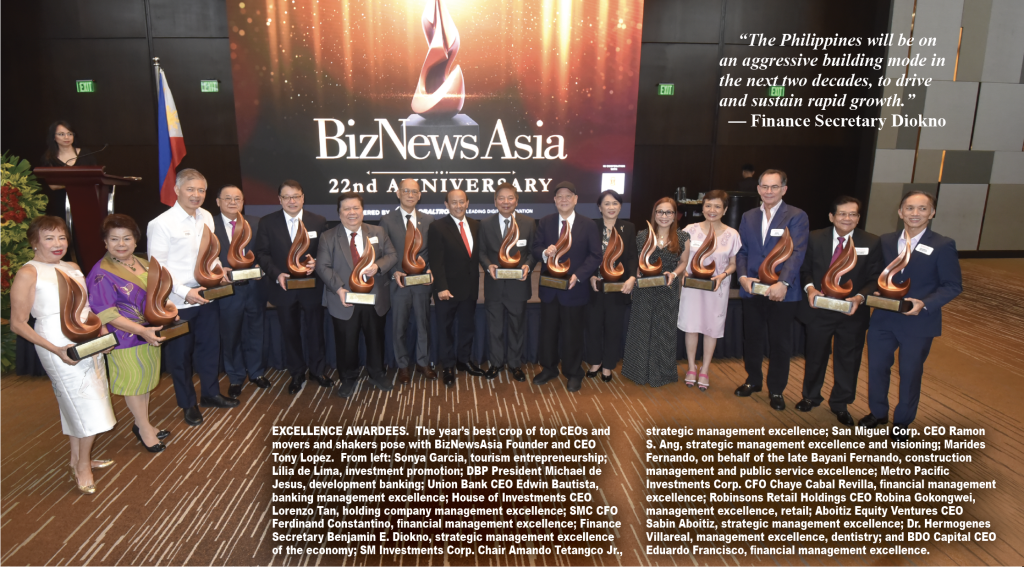By Antonio S. Lopez

At the Nov. 25, 2023 22nd anniversary dinner of BizNewsAsia, Finance Secretary Benjamin E. Diokno painted a bullish outlook for the economy.
The head of the economic team of President Marcos Jr. congratulated BizNewsAsia, “founded and nurtured by my good friend Tony Lopez, on its 22nd anniversary.” “For over two decades,” he said, BizNewsAsia “has shown a spotlight on the most important business and economic issues of our day, bringing to the public consciousness sharp insights on the Philippine economic landscape.”
The BizNewsAsia dinner audience of 200 top businessmen were led by the owners or heads of the Philippines’ biggest conglomerates, including Ramon S. Ang, president-CEO of San Miguel Corp.; Amando Tetangco Jr., chair of SM Investments Corp. (SMIC); Lance Gokongwei, president-CEO of JG Summit Holdings (Gokongwei Group); Sabin Aboitiz, president-CEO of Aboitiz Equity Ventures; and Lorenzo Tan, president-CEO, House of Investments, the holding company of the Yuchengco Group.
SMIC (1,019,167,480,572), JG Summit (289,181,821,650.10) Aboitiz Equity (273,402,577,078.05), and SMC (254,838,545,257.20) are the largest holding companies in market value as of Nov. 28, 2023.
Diokno shared “the enduring strengths of the Philippine economy, as well as the building blocks that the Marcos administration is laying to solidify our path to a more prosperous and inclusive future.”
Highest growth in Southeast Asia
The Philippines will post the highest growth in Southeast Asia, both this year and next, at 5.9 and 6.5%, respectively.
In the third quarter, Diokno told the business elite, “the Philippine economy posted the strongest third quarter growth in the region, at 5.9%. “This robust performance brought our average growth for the first three quarters of the year to 5.5%—faster than our neighbors: China, Indonesia, Vietnam, Malaysia, and Singapore.”
Aggressive building mode
“The Philippines will be on an aggressive building mode in the next two decades, to drive and sustain rapid growth,” the Finance chief announced.
“The government has prioritized 197 infrastructure flagship projects with a total investment requirement of about P8.7 billion.”
Of the 197, 100 are on-going or for implementation. The big ticket projects will unlock greater economic activity thru physical and digital connectivity, health, power and energy, agriculture, flood management.
With easier Public-Private partnership rules, “we are paving the way for impactful, high-quality, and bankable infrastructure projects,” Diokno said.
NAIA and TPLEx Extension approved
Two PPP proposals have been accelerated—the turnover of the Ninoy Aquino International Airport to private investors, and the Tarlac-Pangasinan-La Union Expressway Extension.
The Finance chief gushed: “Our consistently strong economic performance is proof that despite a difficult global environment and domestic challenges, the Philippines remains to be one of the brightest spots in the region.”
He cited the World Bank which expects “the Philippine economy to zoom past its East Asia and Pacific peers this year at 5.6%.”
“We will achieve the lower end of our growth target of 6.0 to 7.0% for the year (2023), and even faster at 6.5 to 8.0% from 2024 to 2028.”
$101 billion reserves
Dollars are plenty to buy raw materials, machinery and equipment, and consumer goods needed by a fast growing economy, with reserves at $101.1 billion. That is equivalent to 7.5 months worth of import cover.
This, Diokno pointed out, “remains well above the IMF’s Assessing Reserve Adequacy (ARA) metric at 1.9 in 2023, remarkably higher than China’s 0.7 as well as Malaysia and Indonesia, both at 1.1”, and “higher than selected Asian and emerging market economies.”
“Having adequate reserves could reduce the likelihood of a balance of payments crisis, help preserve economic and financial stability against pressures on the exchange rates, and create space for fiscal authority,” Diokno explained.
This explains the peso’s recent unusual strength. Predicted to fall to below 60 per US dollar, after depreciating by 15.7% to hit an all-time low of P59 October 2022, the peso has instead rallied to P55 per dollar, close to its average P54.48 in 2022. Diokno expects “the peso-dollar rate to be broadly stable at 53 to 57 per US dollar for the remainder of the medium term.”
Government debt-to-GDP ratio
As of end-September 2023, the national government-debt-to GDP ratio was 60.2%, lower than the Medium Term Fiscal Framework target of 61.2% for 2023. “We remain on track to achieving our medium-term fiscal targets,” Diokno assured.
Diokno said “the Philippines maintains investor-grade credit ratings amid a sea of downgrades in other countries, including the US.”
This November, Fitch Ratings affirmed the Philippines’ triple-B rating with Stable outlook. “This comes on the heels of the rating agency’s upgraded outlook on the Philippines, from Negative to Stable, in May 2023.”
In August 2023, R&I, a Japanese credit rating agency, affirmed the Philippines’ triple-B plus rating and revised its outlook, from stable to positive.
Jobs are being created. To-date, unemployment is 4.6%, from 5.0% in September 2022. “The quality of jobs has also improved with the underemployment rate dropping to a record low of 10.7.” Underemployment used to hover at 15%.
Inflation eases
Headline inflation or raw inflation eased to 4.9% in October 2023, from 6.1% in September 2023, lower than the Bangko Sentral’s forecast of 5.1 to 5.9%.
Still, cautioned Diokno, “the Inter-Agency Committee on Inflation and Market Outlook remains vigilant against emerging supply shocks in the market to ensure timely and well-grounded policy recommendations on mitigating inflationary pressures.”
“The Marcos Jr. administration is all-hands-on deck in its pursuit of rapid growth through the full implementation of business-friendly reforms.”
To further open up our economy to job-generating foreign investments, Diokno related, “the Philippine government liberalized many sectors through the amendments to the Public Service Act, Retail Trade Liberalization Act, Foreign Investments Act, as well as the Renewable Energy Act IRR.”
“We have reformed the Philippines’ corporate tax structure and fiscal incentives system, through the Corporate Recovery and Tax Incentives for Enterprises or CREATE Act to support strategically important industries,” Diokno said.
